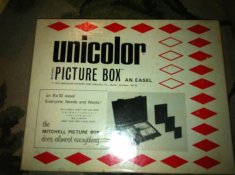StoneNYC
Member
So I got an enlarger finally!!! 
Sadly it looks like it only does 6x6 and I only shoot 6x7 but it's a start...
I got a bunch of free stuff and I have questions..
1. First, is this enlarger any good? It has plastic bellows and a 50mm beslar and 75mm E-Lucky lens, it's called a Lentar L266D and has a 35mm and 6x6 film holder insert.
2. Is a 6x7 available or will that not fit the bellows?

3. Next the most exciting disappointment (I say that as its probably no good), a full, unused pack of 8x10 "Cibachrime Print Material Type A" which I assume is paper and I recall for chrome prints which they don't make anymore right? ... It's been sitting in the persons basement for something like 20 years she says and was her fathers, as well as the manual, and some measure cups which you can see next to the enlarger in the previous picture.

4. Next is some learning books, most notable is the book I think everyone tells me to read, ansel Adams - the negative, but it also says "basic photo 2" so is this only PART of the "The Negative" and not the whole book?

5. Next is what I think is B&W paper... Again, this can't possibly be good right?

6. Next, is this hypo-check any good? And what's "opaque black" for?

7. Next, is this for cutting? What is it?

8. And also what's this??

9. And I think finally, are either of these lights useful and applicable to modern paper or is this stuff for old orthochromatic film?

10. Oh one more... What is this thing? The lady said she thought it might be for paper but it looks like it could be for sheet film also?


I think that's it for questions for now.
Thanks!!
~Stone
Mamiya: 7 II, RZ67 Pro II / Canon: 1V, AE-1, 5DmkII / Kodak: No 1 Pocket Autographic, No 1A Pocket Autographic | Sent w/ iPhone using Tapatalk

Sadly it looks like it only does 6x6 and I only shoot 6x7 but it's a start...
I got a bunch of free stuff and I have questions..
1. First, is this enlarger any good? It has plastic bellows and a 50mm beslar and 75mm E-Lucky lens, it's called a Lentar L266D and has a 35mm and 6x6 film holder insert.
2. Is a 6x7 available or will that not fit the bellows?

3. Next the most exciting disappointment (I say that as its probably no good), a full, unused pack of 8x10 "Cibachrime Print Material Type A" which I assume is paper and I recall for chrome prints which they don't make anymore right? ... It's been sitting in the persons basement for something like 20 years she says and was her fathers, as well as the manual, and some measure cups which you can see next to the enlarger in the previous picture.

4. Next is some learning books, most notable is the book I think everyone tells me to read, ansel Adams - the negative, but it also says "basic photo 2" so is this only PART of the "The Negative" and not the whole book?

5. Next is what I think is B&W paper... Again, this can't possibly be good right?

6. Next, is this hypo-check any good? And what's "opaque black" for?

7. Next, is this for cutting? What is it?

8. And also what's this??

9. And I think finally, are either of these lights useful and applicable to modern paper or is this stuff for old orthochromatic film?

10. Oh one more... What is this thing? The lady said she thought it might be for paper but it looks like it could be for sheet film also?


I think that's it for questions for now.
Thanks!!
~Stone
Mamiya: 7 II, RZ67 Pro II / Canon: 1V, AE-1, 5DmkII / Kodak: No 1 Pocket Autographic, No 1A Pocket Autographic | Sent w/ iPhone using Tapatalk










 .
.